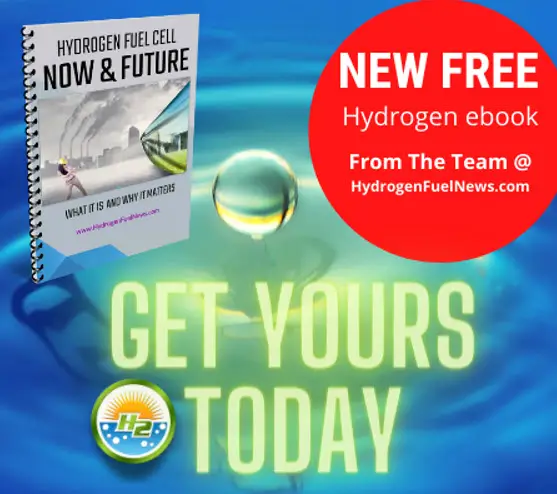
Hydrogen fuel planes and power plants will be here sooner than later
November 10, 2022Electrification isn’t the fastest decarbonization strategy for aviation and other industries.
Hydrogen fuel stock is rising thanks to funding for regional hydrogen hubs and the expansion of tax credits like the Inflation Reduction Act (IRA). More financial support for H2 development and adoption means that costs can come down, making it possible to decarbonize transportation industries that are not easily electrified at a rapid pace, like long-haul trucks, trains, and planes.
Several types of renewable energy make up sustainable jet fuels.
Among these various forms of renewable power include food waste, animal waste, and sewage sludge. Each of these renewables can easily mix with current aviation fuels. In fact, the U.S. Department of Energy Bioenergy Technologies Office says that depending on the feedstock and technologies used to produce the fuel, sustainable aviation fuel (SAF) “can reduce life cycle GHG emissions dramatically compared to conventional jet fuel. Some emerging SAF pathways even have a net-negative GHG footprint.”

Several airline companies have already used biofuels for commercial flights, including Azul Airlines, KLM, British Airways, Lufthansa, Scandinavian Airlines, Virgin Airlines, Virgin Atlantic, and Jet Blue. Specifically, Jet Blue uses sustainable aviation fuel at the company’s hub in the Los Angeles International Airport. To obtain its sustainable aviation fuel, Jet Blue works with World Energy and World Fuel Services.
With the help of tax credits and funding, green hydrogen fuel can become a viable sustainable jet fuel, further reducing the aviation industry’s emissions.
Hydrogen fuel planes could be taking off as soon as 25 years from now.
While SAFs derived from green hydrogen may not happen in the next couple of years, green hydrogen-powered planes could be in the skies within as little as 15 to 25 years. According to a Forbes report, a study by Clean Sky 2 and Fuel Cells & Hydrogen 2 says hydrogen-powered aircrafts could be ready for flight by 2035, with longer flights likely ready by 2050.
“Our ultimate goal is to achieve climate-neutral aviation by 2050,” said Executive Director of Clean Sky 2 Joint Undertaking, Axel Krein. “Turning this ambition into reality requires the seamless integration of a range of important new technological advancements, one of which is hydrogen-powered aircraft.”
However, to produce green hydrogen at the scale needed to make an impact in the aviation industry, the price of green hydrogen fuel has to fall. Currently, hydrogen fuel produced from renewable energy costs approximately $5 per kilogram. If the price falls – especially with the help of support like the IRA – the potential to produce green H2 has no bounds. The number of hydrogen producers can increase and the necessary power plants and infrastructure needed to support the sustainable power can be developed and used on a wide scale for steel manufacturing, energy storage, clean ammonia, heavy-duty trucks, aviation, and beyond.
Hydrogen Cars Poll – Would you drive one if there were more stations? We want to hear from you – Vote Below⤵️[forminator_poll id=”55717″]



 With over 15 years of reporting hydrogen news, we are your premier source for the latest updates and insights in hydrogen and renewable energy.
With over 15 years of reporting hydrogen news, we are your premier source for the latest updates and insights in hydrogen and renewable energy.
If we don’t decarbonize the economy fast, I am pessimistic about the future of the planet. My grandkids will pay the price and that is not acceptable. I have had an electric car since 2011 (Chevy Volt) and I am very happy with it. Hydrogen fuel seems a better long-range alternative to batteries. I have owned FCEL stock for the last 10 years. We need accelerate the development of H as a fuel. Thanks for your efforts.
Food waste is not a renewable energy resource. Animal waste, and sewage sludge is best used for agricultural purposes. The only truly ‘clean’ form of energy is wind, solar, tidal of which there is plenty to power the world. The trick is to convert and store hydrogen from water and ensure is goes safely back into the environment from which is born. Renewable, sustainable, clean hydrogen production and use can only be managed by combining hydrogen and oxygen without combustion using air, which would otherwise result in NOX emissions. Fuel cells are fine and hydrogen/oxygen combustion will result pure water as a by-product. We need to fast-track research and development in these uses, plus greater efficiency of aircraft and other vehicles, including the method by which we move around and control how we move around. And, by the way, this new clean world cannot DeFacto include nuclear.
I live and operate in the decarbonization and PGM industry.
I can tell you without hesitation that this view we can propagate fuel cells in auto, trains, planes, reversible electrolyzer, and green hydrogen generation at any significant scale are misguided.
There simply is only 3.0 to 3.5Moz of Pt available for all things H2 Economy. Even with the best in class Pt loadings on a FCEV today at 26-17 grams, vs projected 11 grams fully design thrifted leads to only some 9M FCEVs a year, and nothing else. Diluting this limited resource accross all of these different applications is diluting it’s effectiveness.
Once regulators realize the limits, it shifts the most optimum deployment strategy.
I have long promoted using these PGMs for long-haul trucking, and prompting a H2 refueling infrastructure to match. Instead CARB (Calif Air Resource Board) keeps subsidizing residential light duty FCEV refueling only, Mistake.
LiBs for EVs are also going to wildly constrained due to mining constraints (Li C Ni Graphite and Nd). The swing to push for more FCEVs will come shortly after that becomes more apparent.